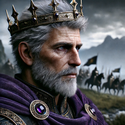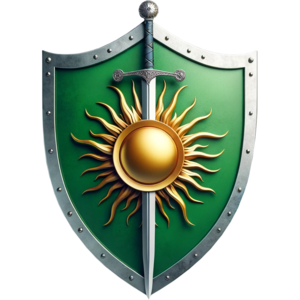Westgard: Difference between revisions
m (→History) |
|||
| (52 intermediate revisions by 2 users not shown) | |||
| Line 1: | Line 1: | ||
{{RealmBox | {{RealmBox | ||
|World = 8 | |World=8 | ||
|RealmID = 61 | |RealmID=61 | ||
|Flag = | |TitleColor=#027400 | ||
}} | |TitleTextColor=white | ||
|Flag=WestgardCrest400.png | |||
|FlagSize=frameless | |||
|FlagCaption=The Shield of Humanity | |||
}}'''The Kingdom of Westgard''' was the first realm to brave the western wilderness of [[Dwilight]] after the great monstrous invasion, formed by a diverse collection of refugees, namely of [[Atamara]]n and [[Far East]]ern origin following the loss of that continent. A fledgling nation surrounded by numberless hordes at first, it struggled for years merely to survive, eventually becoming among the mightiest nations of the continent. Perhaps as a result of the harshness of their uprising, the nobles of Westgard are known to be strong, bold, and proud, when not outright rigid or condescending. | |||
Perhaps as an unsurprising result of these living conditions, Westgardians are largely isolationists, preferring to slaughter monsters than meddle in the affairs of men, and have developed a number of native doctrines and philosophies, such as '''[[The Virtues]]''' and [[/Occidentalism/]]. Occidentalism in the Fourth Era has fallen out and condemned for its arrogance, and is seen as a shameful ideology. | |||
The foreigner or would-be immigrant would be well advised to take into consideration that Westgard is no ordinary realm. Killing monsters isn't just a chore that occurs every now and then. It happens [[/Hunting Campaigns|'''all the time''']]. ''Every day''. Westgard is a well-oiled time-tested monster killing machine. We kill monsters because we have to, but also because we want to, and we got very good at it. | |||
The foreigner or would-be immigrant would be well advised to take into consideration that Westgard is no ordinary realm. Killing monsters isn't just a chore that occurs every now and then. It happens '''all the time'''. ''Every day''. Westgard is a well-oiled time-tested monster killing machine. We kill monsters because we have to, but also because we want to, and we got very good at it | |||
==History== | ==History== | ||
===First Era (2015-12-06 to 2017-03-18)=== | ===[[Westgard/First Era|First Era]] (2015-12-06 to 2017-03-18)=== | ||
The first era is marked by incredibly harsh living conditions, overwhelming monstrous hordes, and the every day struggle to merely survive as a realm. Every time a monstrous invasion was triggered by the folly of the eastern realms, Westgard would be reduced to barely surviving. | The first era is marked by incredibly harsh living conditions, overwhelming monstrous hordes, and the every day struggle to merely survive as a realm. Every time a monstrous invasion was triggered by the folly of the eastern realms, Westgard would be reduced to barely surviving. | ||
Known as "Gelene" at first, the realm adopted the name of Westgard six days later. It grew on rapidly as some of the hordes that had inhabited the west moved on east, taking Aquitain, Ygg d'Razhuul, Sabadell, Ammando, Zereth, Eidulb Outskirts, and even the city of Eidulb itself, on the 6th of February, 2016. By the | Known as "Gelene" at first, the realm adopted the name of Westgard six days later. It grew on rapidly as some of the hordes that had inhabited the west moved on east, taking Aquitain, Ygg d'Razhuul, Sabadell, Ammando, Zereth, Eidulb Outskirts, and even the city of Eidulb itself, on the 6th of February, 2016. By the 21st of March, however, it had nothing left by Gelene and Eidulb (which it had just taken again), the rest had all fallen prey to the rogues. On the 29th, Eidulb too fell, though Gelene Outskirts was retaken the next day. | ||
This era included some creative initiatives in order to try to break the cycles, such as the Great Rush West, aimed at cutting off the monsters' migratory paths from the North-West and thus stop the brooding in the Province of Darfix. Almost successful, the army was forced to pull back after taken Crotona on the third of February 2017, just one region (K'dira) away from success. But the onslaught was relentless, and Westgard was reduced to Gelene, Gelene Outskirts, and Sabadell by the 18th of March. | This era included some creative initiatives in order to try to break the cycles, such as the [[/Great Rush West/]], aimed at cutting off the monsters' migratory paths from the North-West and thus stop the brooding in the Province of Darfix. Almost successful, the army was forced to pull back after taken Crotona on the third of February 2017, just one region (K'dira) away from success. But the onslaught was relentless, and Westgard was reduced to Gelene, Gelene Outskirts, and Sabadell by the 18th of March. | ||
===Second Era (2017-03-19 to 2018-08-20)=== | |||
===[[Westgard/Second Era|Second Era]] (2017-03-19 to 2018-08-20)=== | |||
Then something unexpected happened... the monsters began to swim. Though, at first, this changed little for Westgard. Ammando was a favored location for hitting the seas, and Sabadell remained their favorite region to travel through to reach their destinations. Monsters did not become scarce in the slightest. However, this did mean that, while the monsters breeding in the Province of Darfix were no less relentless, and perhaps even more aggressive, now that they favored swimming from Ammando instead of marching through Yggdramir, those breeding in the Province of Arrows practically ceased coming altogether. Presumably, they now headed for the Gold Sea or the Sea of Silence, though the details of their migratory paths are largely a matter of speculation. | Then something unexpected happened... the monsters began to swim. Though, at first, this changed little for Westgard. Ammando was a favored location for hitting the seas, and Sabadell remained their favorite region to travel through to reach their destinations. Monsters did not become scarce in the slightest. However, this did mean that, while the monsters breeding in the Province of Darfix were no less relentless, and perhaps even more aggressive, now that they favored swimming from Ammando instead of marching through Yggdramir, those breeding in the Province of Arrows practically ceased coming altogether. Presumably, they now headed for the Gold Sea or the Sea of Silence, though the details of their migratory paths are largely a matter of speculation. | ||
So while the growth and crunch cycles continued, with every period of harsh monstrous activity spaced by a period of relative calmness, these cycles distinguished themselves by the quantity and quality of the regions remaining under control after each cycle. Instead of being reduced to next to nothing, a growing number of regions belonged to the "core" that was almost never lost at all. Border regions like the Shrine of Seeklander got to build vast walls to protect themselves from the hordes. What was once our maximal expanse became more or less our minimal expanse, and we even began annexing some far-away regions such as the city of Gaston. | So while the growth and crunch cycles continued, with every period of harsh monstrous activity spaced by a period of relative calmness, these cycles distinguished themselves by the quantity and quality of the regions remaining under control after each cycle. Instead of being reduced to next to nothing, a growing number of regions belonged to the "core" that was almost never lost at all. Border regions like the Shrine of Seeklander got to build vast walls to protect themselves from the hordes. What was once our maximal expanse became more or less our minimal expanse, and we even began annexing some far-away regions such as the city of Gaston. | ||
===Third Era (2018-08-21 to | |||
Unprecedented prosperity that began roughly with the [[ | ===[[Westgard/Third Era|Third Era]] (2018-08-21 to 2020-02-21)=== | ||
Unprecedented prosperity that began roughly with the [[/One Mad Week|Week of Madness]]. Incapacitated for a full week, the army was left mostly paralyzed. But despite this, the realm remained pretty much intact. Once they regained their sense, the hordes could be seen flocking to Luria Nova, and then the remaining hordes vanished. In the face of this never before seen calm, Westgard pressed on, taking region after region. Knowing they could only control so large with the numbers of nobles it had, it also started the "An Ale For a Bale" program, exchanging Westgardian ale for foodstuff in various regions the realm had no intention to keep, such as Jorradith and Knyazes. Gaston was taken once more, and Duil was taken for the first time. And while a number of hordes were still to be seen all over, at but a few dozen beasts a horde, it was almost as if they weren't there at all. And so when the two armies finally returned from a month-long expedition, the beasts were mostly exterminated after the first week of November. | |||
Shortly thereafter, [[Tol Goldora|opportunists]] from the East decided to take advantage of the calm Westgard brought to the West and decided to takeover [[Golden Farrow]], which Westgard was just about to take itself. Shocked by this opportunism, Westgard sent scouts to learn more about this new realm, and found them brutalizing every region their army crossed. Determined to put an end to the suffering of the inhabitants of the Province of Arrows, Westgard attempted a diplomatic solution, offering aid to relocate, which the colony refused, and so Westgard [[/Stand Against Barbarism|marched into the city]] to put an end to their villainy. After a week of distributing free goods to the locals, the city raised Westgard's flag, despite attempts by the [[De La Fere Family/Nigel|barbarians]] to starve their own city and corrupt the officials simply to spite Westgard for its righteous opposition, which simply further strengthened the army's resolve to put an end to this villainy for good. | |||
===[[Westgard/Fourth Era|Fourth Era]] (2020-02-22 to 2022-07-23)=== | |||
The Gold Sea Conflict was ended with the acceptance of the Golden Farrow Accords, proposed by High King Gheric Arylon, and marked the end of the ruinous third era and an end to failed policies that had lead to the ruinous Gold Sea Conflict in the first place, with Westgard seeking to return to its role as the Shield of Humanity, and not a conqueror of man. The arrogance of former Exarch Selena Chenier had brought ruin to Westgard, the lands had become overrun and the war had become unfeasible. Occidentalism has fallen out, regarded as the foolish arrogance of the past which only brought ruin to Westgard, and the Virtues once again are becoming the foundations of the realm. | |||
The Fourth Era was signified by clashing views about the realm’s future. Although Westgard reclaimed her lost territory, and regained past prosperity, this was brought to a halt in the time of the ‘’’Yellow Daggers’’’. After the failed tenure of Lord Commander Felix Carson, several vocal nobles began to complain about the direction the realm was heading. Nobles were leaving, many for Avernus who were settling Darfix, and Westgard entered a period of territorial decline, lacking the nobles to hold Gaston and the Western reaches. | |||
In the midst of this decline, the coward Henrik Thrane launched a rebellion against the rule of High King Gheric and was joined by Lord Commander Kenneth Gotz and the Dame Bridgette Tempest. The three traitors were met with a fierce and numerous loyalist contigent and were defeated after a single battle in Gelene. When it was apparent his grab for power was doomed to fail, the rebel Master of the Mint Henrik depleted the realm's grain stores, and the three rebels fled the realm, disgracefully refusing duel challenges by the Loyalist commander, Flavia Schwarzherzig. | |||
During the rule of Flavia Schwarzherzig her rigid attitude resulted in expeditions to exact tribute from regions which did not want to support Westgard’s defense of mankind. Not everyone in Westgard agreed to this policy and her sudden disappearance is controversial. It is, however, never discussed openly for opponents do not take pride in claiming the death of the hero of the Yellow Daggers, while proponents understand the seriousness of accusing a brother in arms of such an act. | |||
High King Lowry Cameron sought to bring stability to the declining realm. In order to bring unity he ended elections, but could not turn the tides as the decline continued. When a growing number of nobles became disgruntled and a civil war loomed, Lowry did the unthinkable: he voluntarily released power. He showed the Westgardian warriors that conflicts can be solved without force and thus united the realm by his final act. | |||
===[[Westgard/Fifth Era|Fifth Era]] (2022-07-24 to present day)=== | |||
Westgard again turned to Gheric Arylon, but would also face a new threat in an old enemy: Kenneth Gotz was intend on destroying Westgard and started sending assassins – the most infamous of them being [[Tideweaver Family|Seifer Tideweaver]]. He had attempted numerous assaults on High King Gheric and High Adjudicator Lowry. When it became clear that [[Luria Nova]] supported these attacks, Gheric was forced to declare the [[Tideweaver War]]. The war saw little action, although Westgard went through many High Adjudicators. When [[Luria Nova]] agreed to send no more assassins, peace was signed. | |||
After the death of Klaus Raphin and the appearence of another [[Luria Nova|Lurian]] assassin, a rebellion loomed as people questioned Westgard's ability to continue to protect them. But the execution of [[Tideweaver Family|Seifer]] restored the faith in the realm and even gained the faith of neighbouring territories, allowing Westgard to expand to [[Zereth]], [[Forguthrie]] and [[Gaston Farms]]. The Great [[Astrum|Astrumese]] Expansion followed soon after when many [[Astrum|Astrumese]] nobles decided to cross the sea and strengthen Westgard. It allowed the annexation of [[Ygg d'Razhuul]], [[Aquitain]], [[Shrine of Seeklander]], [[Mountain of Woe]] and [[Libidizedd]]. | |||
With both Westgard and [[Wicrose]] claiming the right to the [[Astrum|Astrumese]] place of birth, [[Libidizedd]], tensions escalated into the [[Dwilight/Astrumese_Succession_War|Astrumese Succession War]]. | |||
==Ruling Line of Westgard== | |||
{{Westgardrulers}} | |||
==Military== | ==Military== | ||
Westgard now has one army in its service. | |||
* Westgard Lightbearers - retired from service, having been shamed in the Battle of Demyansk by the arrogance of its commander. | |||
* Westgard Sun Swords - Served in the First Era and probably the early days of the Second Era, helped split the armed forces in order to better react to omnipresent hordes. Was disbanded when the hordes became too great and Westgard's armies became battered, forcing the realm to act in total unison once more. Was temporarily revived in the Third Era, during the Gold Sea Conflict. After the time of Yellow Daggers it was revived again by the Duke of [[Gelene]] and served for a time as the prime military force until the Duke was relieved as Lord Commander. | |||
* Westgard Wardens - Created during the Gold Sea Conflict, helps Westgard's forces cover greater terrain. Now retired. | |||
* The Shield of the West - Established in the Fourth Era and served as the primary defensive army of Westgard. Reduced to honorary guard at the start of the Fifth Era to unite the combat forces into the Westgard Sun Swords. After the Great Astrumese Expansion it became the main force, when the High King decided to take responsibility for the army. | |||
===Hall of Heroes=== | |||
Heroes who died in service to Westgard | |||
* [[/Heroes/Adair|2018-11-30: Adair O'Deathh]] was killed by monsters in the defense of [[Eidulb Outskirts]]. | |||
* 2022-11-11: Klaus Raphin was killed by monsters in [[Jorradith]] while guarding the way back for a hunting expedition to the far west. | |||
* 2022-12-08: [[Poe Family|Agatha Poe]] succumbed to her wounds after a duel against Kenneth Gotz, traitor during the Yellow Knives and instigator of the [[Tideweaver War]]. | |||
* 2023-02-01: Mucho Gigantus was overwhelmed by monsters while guarding [[Duil]] during the conquest of [[Libidizedd]]. | |||
While specialized in fighting the monsters, Westgard has been involved in three wars. | |||
* First Colonial Dispute - A small conflict in Westgard's early days, with Astrum over claims. | |||
* [[/Stand Against Barbarism/]] - War against the reavers of Tol Goldora, which turned continental after Tol's allies came in to their defense, and Westgard's allies came in to retaliate. Now referred to as the Gold Sea Conflict, the war proved to be ruinous to Westgard, and serves now as a lesson to future generations of Westgard, and a reminder of her true purpose... Not to wage war upon man, but to be its Shield. | |||
* [[Tideweaver War]] - After numerous murder attempts by the [[Luria Nova|Lurian]] backed [[Tideweaver Family|Seifer Tideweaver]] High King Gheric Arylon was forced to declare war. | |||
* [[Dwilight/Astrumese_Succession_War|Astrumese Succession War]] - After the fall of [[Astrum]], Westgard took control of [[Libidizedd]]. [[Wicrose]] claimed the former [[Astrum|Astrumese]] city. Tensions escalated when the [[Wicrose|Wiccan]] infiltrator [[Wilde Family|Eiric Wilde]] wreaked havoc on Westgardian lands. | |||
==Religions== | ==Religions== | ||
Westgardians are taught from their earliest years to protect all people - and therefore all religions. For this reason nobles have a tendency not to adhere to a particular religion - although the defunct [[The Virtues]] is the official doctrine of the realm, and taught to nobility from their earliest years. | |||
This does not mean that there is no religion in Westgard. Most of the commoners follow [[Sanguis Astroism]], except in [[Gelene]] and on the [[Mountain of Woe]]. It is also found among the nobility, especially those of [[Astrum|Astrumese]] descend. Another religion, which can be found in Westgard, is [[Twillen Poitrasm]]. This is found mainly among commoners and nobles on the Great Western Wall. | |||
==Doctrines and policies== | ==Doctrines and policies== | ||
Various documents relating to Westgardian politics. | Various documents relating to Westgardian politics. | ||
*[[ | *[[/Laws|Codified Laws]] | ||
*[[ | *[[/Ecumen|Westgardian Ecumen]] | ||
*[[/Territories|Westgardian Sphere of Influence]] | |||
*[[/Codex Anathema/]] | |||
Latest revision as of 18:07, 1 July 2024
| Kingdom of Westgard
The Shield of Humanity | |
| Overview | |
| Nobles | 14 |
| Council | |
| High King | Gheric Arylon |
| Master of the Mint | Sparticus II Bathgate |
| Regions | |
The Kingdom of Westgard was the first realm to brave the western wilderness of Dwilight after the great monstrous invasion, formed by a diverse collection of refugees, namely of Atamaran and Far Eastern origin following the loss of that continent. A fledgling nation surrounded by numberless hordes at first, it struggled for years merely to survive, eventually becoming among the mightiest nations of the continent. Perhaps as a result of the harshness of their uprising, the nobles of Westgard are known to be strong, bold, and proud, when not outright rigid or condescending.
Perhaps as an unsurprising result of these living conditions, Westgardians are largely isolationists, preferring to slaughter monsters than meddle in the affairs of men, and have developed a number of native doctrines and philosophies, such as The Virtues and Occidentalism. Occidentalism in the Fourth Era has fallen out and condemned for its arrogance, and is seen as a shameful ideology.
The foreigner or would-be immigrant would be well advised to take into consideration that Westgard is no ordinary realm. Killing monsters isn't just a chore that occurs every now and then. It happens all the time. Every day. Westgard is a well-oiled time-tested monster killing machine. We kill monsters because we have to, but also because we want to, and we got very good at it.
History
First Era (2015-12-06 to 2017-03-18)
The first era is marked by incredibly harsh living conditions, overwhelming monstrous hordes, and the every day struggle to merely survive as a realm. Every time a monstrous invasion was triggered by the folly of the eastern realms, Westgard would be reduced to barely surviving.
Known as "Gelene" at first, the realm adopted the name of Westgard six days later. It grew on rapidly as some of the hordes that had inhabited the west moved on east, taking Aquitain, Ygg d'Razhuul, Sabadell, Ammando, Zereth, Eidulb Outskirts, and even the city of Eidulb itself, on the 6th of February, 2016. By the 21st of March, however, it had nothing left by Gelene and Eidulb (which it had just taken again), the rest had all fallen prey to the rogues. On the 29th, Eidulb too fell, though Gelene Outskirts was retaken the next day.
This era included some creative initiatives in order to try to break the cycles, such as the Great Rush West, aimed at cutting off the monsters' migratory paths from the North-West and thus stop the brooding in the Province of Darfix. Almost successful, the army was forced to pull back after taken Crotona on the third of February 2017, just one region (K'dira) away from success. But the onslaught was relentless, and Westgard was reduced to Gelene, Gelene Outskirts, and Sabadell by the 18th of March.
Second Era (2017-03-19 to 2018-08-20)
Then something unexpected happened... the monsters began to swim. Though, at first, this changed little for Westgard. Ammando was a favored location for hitting the seas, and Sabadell remained their favorite region to travel through to reach their destinations. Monsters did not become scarce in the slightest. However, this did mean that, while the monsters breeding in the Province of Darfix were no less relentless, and perhaps even more aggressive, now that they favored swimming from Ammando instead of marching through Yggdramir, those breeding in the Province of Arrows practically ceased coming altogether. Presumably, they now headed for the Gold Sea or the Sea of Silence, though the details of their migratory paths are largely a matter of speculation.
So while the growth and crunch cycles continued, with every period of harsh monstrous activity spaced by a period of relative calmness, these cycles distinguished themselves by the quantity and quality of the regions remaining under control after each cycle. Instead of being reduced to next to nothing, a growing number of regions belonged to the "core" that was almost never lost at all. Border regions like the Shrine of Seeklander got to build vast walls to protect themselves from the hordes. What was once our maximal expanse became more or less our minimal expanse, and we even began annexing some far-away regions such as the city of Gaston.
Third Era (2018-08-21 to 2020-02-21)
Unprecedented prosperity that began roughly with the Week of Madness. Incapacitated for a full week, the army was left mostly paralyzed. But despite this, the realm remained pretty much intact. Once they regained their sense, the hordes could be seen flocking to Luria Nova, and then the remaining hordes vanished. In the face of this never before seen calm, Westgard pressed on, taking region after region. Knowing they could only control so large with the numbers of nobles it had, it also started the "An Ale For a Bale" program, exchanging Westgardian ale for foodstuff in various regions the realm had no intention to keep, such as Jorradith and Knyazes. Gaston was taken once more, and Duil was taken for the first time. And while a number of hordes were still to be seen all over, at but a few dozen beasts a horde, it was almost as if they weren't there at all. And so when the two armies finally returned from a month-long expedition, the beasts were mostly exterminated after the first week of November.
Shortly thereafter, opportunists from the East decided to take advantage of the calm Westgard brought to the West and decided to takeover Golden Farrow, which Westgard was just about to take itself. Shocked by this opportunism, Westgard sent scouts to learn more about this new realm, and found them brutalizing every region their army crossed. Determined to put an end to the suffering of the inhabitants of the Province of Arrows, Westgard attempted a diplomatic solution, offering aid to relocate, which the colony refused, and so Westgard marched into the city to put an end to their villainy. After a week of distributing free goods to the locals, the city raised Westgard's flag, despite attempts by the barbarians to starve their own city and corrupt the officials simply to spite Westgard for its righteous opposition, which simply further strengthened the army's resolve to put an end to this villainy for good.
Fourth Era (2020-02-22 to 2022-07-23)
The Gold Sea Conflict was ended with the acceptance of the Golden Farrow Accords, proposed by High King Gheric Arylon, and marked the end of the ruinous third era and an end to failed policies that had lead to the ruinous Gold Sea Conflict in the first place, with Westgard seeking to return to its role as the Shield of Humanity, and not a conqueror of man. The arrogance of former Exarch Selena Chenier had brought ruin to Westgard, the lands had become overrun and the war had become unfeasible. Occidentalism has fallen out, regarded as the foolish arrogance of the past which only brought ruin to Westgard, and the Virtues once again are becoming the foundations of the realm.
The Fourth Era was signified by clashing views about the realm’s future. Although Westgard reclaimed her lost territory, and regained past prosperity, this was brought to a halt in the time of the ‘’’Yellow Daggers’’’. After the failed tenure of Lord Commander Felix Carson, several vocal nobles began to complain about the direction the realm was heading. Nobles were leaving, many for Avernus who were settling Darfix, and Westgard entered a period of territorial decline, lacking the nobles to hold Gaston and the Western reaches.
In the midst of this decline, the coward Henrik Thrane launched a rebellion against the rule of High King Gheric and was joined by Lord Commander Kenneth Gotz and the Dame Bridgette Tempest. The three traitors were met with a fierce and numerous loyalist contigent and were defeated after a single battle in Gelene. When it was apparent his grab for power was doomed to fail, the rebel Master of the Mint Henrik depleted the realm's grain stores, and the three rebels fled the realm, disgracefully refusing duel challenges by the Loyalist commander, Flavia Schwarzherzig.
During the rule of Flavia Schwarzherzig her rigid attitude resulted in expeditions to exact tribute from regions which did not want to support Westgard’s defense of mankind. Not everyone in Westgard agreed to this policy and her sudden disappearance is controversial. It is, however, never discussed openly for opponents do not take pride in claiming the death of the hero of the Yellow Daggers, while proponents understand the seriousness of accusing a brother in arms of such an act.
High King Lowry Cameron sought to bring stability to the declining realm. In order to bring unity he ended elections, but could not turn the tides as the decline continued. When a growing number of nobles became disgruntled and a civil war loomed, Lowry did the unthinkable: he voluntarily released power. He showed the Westgardian warriors that conflicts can be solved without force and thus united the realm by his final act.
Fifth Era (2022-07-24 to present day)
Westgard again turned to Gheric Arylon, but would also face a new threat in an old enemy: Kenneth Gotz was intend on destroying Westgard and started sending assassins – the most infamous of them being Seifer Tideweaver. He had attempted numerous assaults on High King Gheric and High Adjudicator Lowry. When it became clear that Luria Nova supported these attacks, Gheric was forced to declare the Tideweaver War. The war saw little action, although Westgard went through many High Adjudicators. When Luria Nova agreed to send no more assassins, peace was signed.
After the death of Klaus Raphin and the appearence of another Lurian assassin, a rebellion loomed as people questioned Westgard's ability to continue to protect them. But the execution of Seifer restored the faith in the realm and even gained the faith of neighbouring territories, allowing Westgard to expand to Zereth, Forguthrie and Gaston Farms. The Great Astrumese Expansion followed soon after when many Astrumese nobles decided to cross the sea and strengthen Westgard. It allowed the annexation of Ygg d'Razhuul, Aquitain, Shrine of Seeklander, Mountain of Woe and Libidizedd.
With both Westgard and Wicrose claiming the right to the Astrumese place of birth, Libidizedd, tensions escalated into the Astrumese Succession War.
Ruling Line of Westgard
| RULING LINE OF WESTGARD | ||||
| Portrait | Ruler | Reign Begin | Reign Ended | Notes |
|---|---|---|---|---|

|
Archon Faldron Nethercoate | December 16, 2015 | March 19, 2016 | First ruler of the newly established realm of Westgard, established as a western colony of many refugees. Faldron, hailing from Atamara, had only ever been a Count. The inexperienced noble would have a difficult task ahead of him due to the massive hordes that still roamed the west. During his reign Westgard would expand and contract numerous times. The fierce rogue hordes pushed the realm to the brink of destruction more than once, even getting the fledgling realm down to one or two regions. One of the most notable moments of Archon Faldron's reign was the creation of The Virtues. These Virtues, penned by Alyssa Fontaine, would become the cornerstone of Westgardian life. In the end, Archon Faldron would eventually become ill, disappearing from Westgard, never to be heard from again. |

|
Archon Aarn Hemmingst | March 22, 2016 | October 2, 2016 | This period was one of savage desperation across Dwilight, but during Aarn's reign, Westgard would recover from the brink of death. Luria Boreal in the far south had been destroyed by the hordes, while Swordfell, Luria Nova, Fissoa, and Madina had all withered away as their realms were ravaged. It was only Westgard that miraculously prospered. It was during this time that Westgard earned the reputation as being "The Shield of Mankind" for its brave and heroic defense of all human realms. Aarn was a warrior-King who frequently led Westgard's armies against the hordes, often facing unwinnable battles against twenty-plus thousand beasts. Eventually, he would propose the idea of taking the Shrine of Seeklander to create a buffer against the Western onslaught, which proved to be ultimately futile. The endless slaughter and seeming futility of Westgard's mission led to madness and paranoia in the Archon, and he ultimately disappeared under mysterious circumstances. |

|
Archon Rosalind Foxglove | October 6, 2016 | November 1, 2019 | Longest consecutively serving ruler in Westgard history. Rosalind went to war with Tol Goldora to press and preserve Westgard's claim on the city of Golden Farrow, ultimately capturing the city and defending it successfully against the Goldorans. Fought a war of attrition against not only the Goldorans, but a continental alliance which had materialize to oppose Westgard. Ultimately preserved ownership of the Golden City, while seeing much of the rural countryside turned to ash. Accused by her enemies of betraying Westgard's mandate as the "Shield of Humanity" by warring with human realms. The Gold Sea War continued for years, and Rosalind was only able to maintain an uneasy stalemate. Ultimately, she retired from the throne, hoping another could end the conflict decisively for Westgard. |

|
Archon Lukan Fuor | November 5, 2019 | January 6, 2020 | Strong advocate of the war against Tol Goldora. He prosecuted an aggressive campaign against the Goldorans, hoping to end the war by destroying their ability to make war. Under his leadership, Westgard engaged in a controversial and devastating war of attrition which left both Westgard and Tol Goldora in ruins, to the horror of the continent. Lukan's decisions in the war opened up Westgard to a devastating counterstroke, as Goldora engaged in guerrilla warfare in response. He oversaw a great decline in territorial holdings controlled by Westgard as the war continued to take its toll on both nations, leaving both on the precipice of disintegration. Lukan, feeling he was unable to achieve total victory, stepped aside. |
| The Government of Westgard was formally reorganized by Gheric Arylon. The title of the ruler was restyled "High King" to honor the Everguardian Kingdom, which was the first to establish civilization in the west where Westgard now stands, and in which he was born. | ||||

|
High King Gheric Arylon | January 6, 2020 | January 6, 2021 | Son of Fisc Arylon, the former High King of Everguard, the geographic and ideological precursor to Westgard. Forged continental peace on Dwilight and ended the Gold Sea War with the creation of the Golden Farrow Accords. Journeyed to the heart of Zuma lands in response to their destruction of the fortress of Valkyrja. Instrumental in the recapture of the great city of Darfix by Avernus. Crushed an insurrection by Henrik Thrane, The Betrayer. Reformed government and created two new duchies. Founded The Order of the Emerald Shield. Expanded Westgard to its largest territorial holdings in the history of the realm as Westgard recovered from the war, with the realm stretching as far west as the city of Gaston. The period of his rule is known today as the Golden Age of Westgard. Gheric chose to step aside to allow his wife Alessia to carry on his legacy. |

|
High Queen Alessia de Medici | January 6, 2021 | April 6, 2021 | Wife of the former High King Gheric Arylon, and former High Adjudicator. Was informally referred to as the "Most Serene Queen of Westgard" by her partisans. Her rule was difficult for the realm, as post-war political divisions began to become apparent in Westgard. The new economic prosperity and ascendent aristocracy caused conflict over resources, and the nobility pushed for a larger role in the Kingdom's affairs. Alessia's political position was complicated by her Lurian blood, and former citizenship in Tol Goldora, which made the native Westgard population suspicious of her rule. Made Constitutional reform and devolution of power central to her reign, a legacy which remains with Westgard to this day. Ultimately, she was unable to maintain her power base and stepped aside. She mysteriously disappeared shortly thereafter. |

|
High Queen Flavia Schwarzherzig | April 6, 2021 | July 19, 2021 | Presided over a period of stability in the realm, with a somewhat declined territorial holding taking shape over time. Flavia was a great critic of Westgard's motives and role in the Gold Sea War, and she loudly condemned the entire affair as a tragic mistake. An non-interventionist suspicious of foreign entanglements, her foreign policy focused on continued agnosticism as to the other realms on the continent. She engaged in a controversial program of territorial raids of rogue lands to gather resources for Westgard, which she believed was necessary due to the loss of the productive capacity of several key regions once held by the Kingdom. Her leadership divided the realm, inspiring opposition parties to form. Her political position weakened, she ultimately abandoned the Crystal Throne and disappeared under mysterious circumstances. She has not been seen since. |

|
High King Lucky Harte | July 19, 2021 | November 16, 2021 | Decline had taken shape all around Westgard, and the realm was suffering from a malaise. A former trader and Cortier, Lucky Harte was elected promising to develop new resources that could lead to economic prosperity and lead Westgard into, as he called it, "another Golden Era." This proved to be harder than he anticipated, however, and he was not able to achieve any major initiatives. During his tenure, the Kingdom eroded further and there was a sharp decline in the vitality of the realm. Lucky spent but a short time on the Crystal Throne, ultimately unable to achieve his goals. Historians, however, regard him as a decent man and credit him with stabilizing Westgard's divided political situation, which took shape in his predecessor's reign. |

|
High King Lowry Cameron | November 16, 2021 | July 23, 2022 | High King Lowry Cameron came to power hoping to restore stability to Westgard after the slow and precipitous decline experienced by the Kingdom prior to his ascension. Unfortunately, he did not seem as engaged in ruling the Kingdom as he would need to be in order to restore the realm's greatness. As a result, his rule saw Westgard shrink to its smallest territorial holding in a generation. Controversially, he reformed the government and ended elections for the Emerald Crown, declaring himself High King for life. Over time, the realm continued to whither away, until the remaining nobility of Westgard began to protest his leadership and demand he step down. High King Lowry abdicated honorably, in accordance with the wishes of Westgard. |

|
High King Gheric Arylon | July 26, 2022 | Currently serving | Having previously served as High King, Gheric was once again chosen for the Crystal Throne, promising to reverse the near destruction of Westgard. He ultimately became the longest-serving ruler in Westgard history. During his tenure, an assassin from Luria Nova attempted to kill the High King, and in response Gheric declared war on the Lurians. The war ended with the death of the Lurian assassin. Afterward, he engineered the immigration of several citizens from Astrum to Westgard, helping to radically expand Westgard's borders and making good on his promise to restore the prominence of the realm. During his reign, Westgard once again commanded regions that had long since been abandoned. Later, the realm of Wicrose engaged in destructive attacks on Westgard, and in response Gheric was forced to declare war to protect the realm. Westgard recovered Libidizedd, and pressed the fight into the East, wiping out Wicrose's ability to wage war and leaving the realm in ashes. |
Military
Westgard now has one army in its service.
- Westgard Lightbearers - retired from service, having been shamed in the Battle of Demyansk by the arrogance of its commander.
- Westgard Sun Swords - Served in the First Era and probably the early days of the Second Era, helped split the armed forces in order to better react to omnipresent hordes. Was disbanded when the hordes became too great and Westgard's armies became battered, forcing the realm to act in total unison once more. Was temporarily revived in the Third Era, during the Gold Sea Conflict. After the time of Yellow Daggers it was revived again by the Duke of Gelene and served for a time as the prime military force until the Duke was relieved as Lord Commander.
- Westgard Wardens - Created during the Gold Sea Conflict, helps Westgard's forces cover greater terrain. Now retired.
- The Shield of the West - Established in the Fourth Era and served as the primary defensive army of Westgard. Reduced to honorary guard at the start of the Fifth Era to unite the combat forces into the Westgard Sun Swords. After the Great Astrumese Expansion it became the main force, when the High King decided to take responsibility for the army.
Hall of Heroes
Heroes who died in service to Westgard
- 2018-11-30: Adair O'Deathh was killed by monsters in the defense of Eidulb Outskirts.
- 2022-11-11: Klaus Raphin was killed by monsters in Jorradith while guarding the way back for a hunting expedition to the far west.
- 2022-12-08: Agatha Poe succumbed to her wounds after a duel against Kenneth Gotz, traitor during the Yellow Knives and instigator of the Tideweaver War.
- 2023-02-01: Mucho Gigantus was overwhelmed by monsters while guarding Duil during the conquest of Libidizedd.
While specialized in fighting the monsters, Westgard has been involved in three wars.
- First Colonial Dispute - A small conflict in Westgard's early days, with Astrum over claims.
- Stand Against Barbarism - War against the reavers of Tol Goldora, which turned continental after Tol's allies came in to their defense, and Westgard's allies came in to retaliate. Now referred to as the Gold Sea Conflict, the war proved to be ruinous to Westgard, and serves now as a lesson to future generations of Westgard, and a reminder of her true purpose... Not to wage war upon man, but to be its Shield.
- Tideweaver War - After numerous murder attempts by the Lurian backed Seifer Tideweaver High King Gheric Arylon was forced to declare war.
- Astrumese Succession War - After the fall of Astrum, Westgard took control of Libidizedd. Wicrose claimed the former Astrumese city. Tensions escalated when the Wiccan infiltrator Eiric Wilde wreaked havoc on Westgardian lands.
Religions
Westgardians are taught from their earliest years to protect all people - and therefore all religions. For this reason nobles have a tendency not to adhere to a particular religion - although the defunct The Virtues is the official doctrine of the realm, and taught to nobility from their earliest years.
This does not mean that there is no religion in Westgard. Most of the commoners follow Sanguis Astroism, except in Gelene and on the Mountain of Woe. It is also found among the nobility, especially those of Astrumese descend. Another religion, which can be found in Westgard, is Twillen Poitrasm. This is found mainly among commoners and nobles on the Great Western Wall.
Doctrines and policies
Various documents relating to Westgardian politics.

